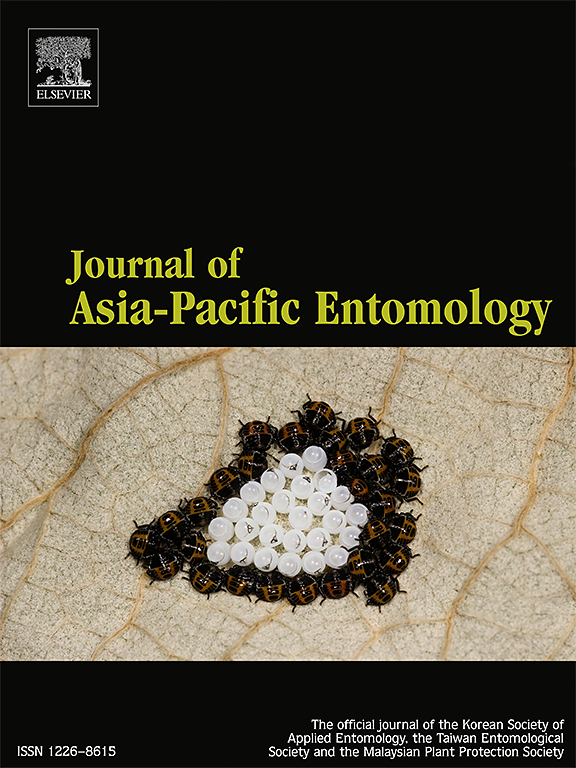Novel splice variants of the cytochrome P450 9A19 gene in the domestic silkworm Bombyx mori
IF 1.3
3区 农林科学
Q3 ENTOMOLOGY
引用次数: 0
Abstract
CYP9 gene family members participate in neutralization pathways associated with pesticide resistance. Alternative splicing ultimately plays a role in increasing the diversity of the proteome through increasing transcriptome diversity. Here, we characterized various novel CYP9A19 isoforms in Bombyx mori. We first identified an exon 4 deletion isoform that was 203 bp smaller than expected due to a deletion of exon 4 from the protein coding sequence (CDS) region of the CYP9A19 cDNA. Within the CYP9A19 cDNA, there is a 176 bp 5′-untranslated region (UTR); reverse transcription-polymerase chain reaction results showed 74 bp lower and 122 bp higher molecular-weight products compared with the expected size from the 5′-UTR of CYP9A19 cDNA in B. mori. Additionally, we found a new sequence (5′-GTCTCAGGTTCAGGGCTCTAGCAATTTTTCACAG-3′) in the 5′-UTR of CYP9A19. Currently, our understanding of the various CYP9A19 isoform functions in pesticide degradation and resistance and insect development and differentiation stages remains limited. Therefore, additional studies on the alternative splicing process are needed to verify the biological role of the novel splicing variant of CYP9A19 in B. mori. Our findings may provide insight into the genetic background of the processes and mechanisms underlying the stages of insect development and differentiation in lepidoptera species.

家蚕细胞色素P450 9A19基因的新剪接变异
CYP9基因家族成员参与与农药抗性相关的中和途径。选择性剪接最终通过增加转录组多样性来增加蛋白质组的多样性。在这里,我们在家蚕中发现了多种新的CYP9A19亚型。由于CYP9A19 cDNA蛋白质编码序列(CDS)区域的外显子4缺失,我们首先发现了一个比预期小203bp的外显子4缺失异构体。在CYP9A19 cDNA中,存在一个176 bp的5 ' -未翻译区(UTR);逆转录聚合酶链反应结果显示,与家蚕CYP9A19 cDNA 5′-UTR序列的预期分子量相比,产物分子量降低了74 bp,分子量增加了122 bp。此外,我们在CYP9A19的5 ' -UTR中发现了一个新的序列(5 ' -GTCTCAGGTTCAGGGCTCTAGCAATTTTTCACAG-3 ')。目前,我们对各种CYP9A19亚型在农药降解和抗性以及昆虫发育和分化阶段的功能的了解仍然有限。因此,需要进一步研究可选剪接过程,以验证新的剪接变异CYP9A19在家蚕中的生物学作用。我们的发现可能为了解鳞翅目昆虫发育和分化阶段的过程和机制的遗传背景提供见解。
本文章由计算机程序翻译,如有差异,请以英文原文为准。
求助全文
约1分钟内获得全文
求助全文
来源期刊

Journal of Asia-pacific Entomology
Agricultural and Biological Sciences-Insect Science
CiteScore
2.70
自引率
6.70%
发文量
152
审稿时长
69 days
期刊介绍:
The journal publishes original research papers, review articles and short communications in the basic and applied area concerning insects, mites or other arthropods and nematodes of economic importance in agriculture, forestry, industry, human and animal health, and natural resource and environment management, and is the official journal of the Korean Society of Applied Entomology and the Taiwan Entomological Society.
 求助内容:
求助内容: 应助结果提醒方式:
应助结果提醒方式:


